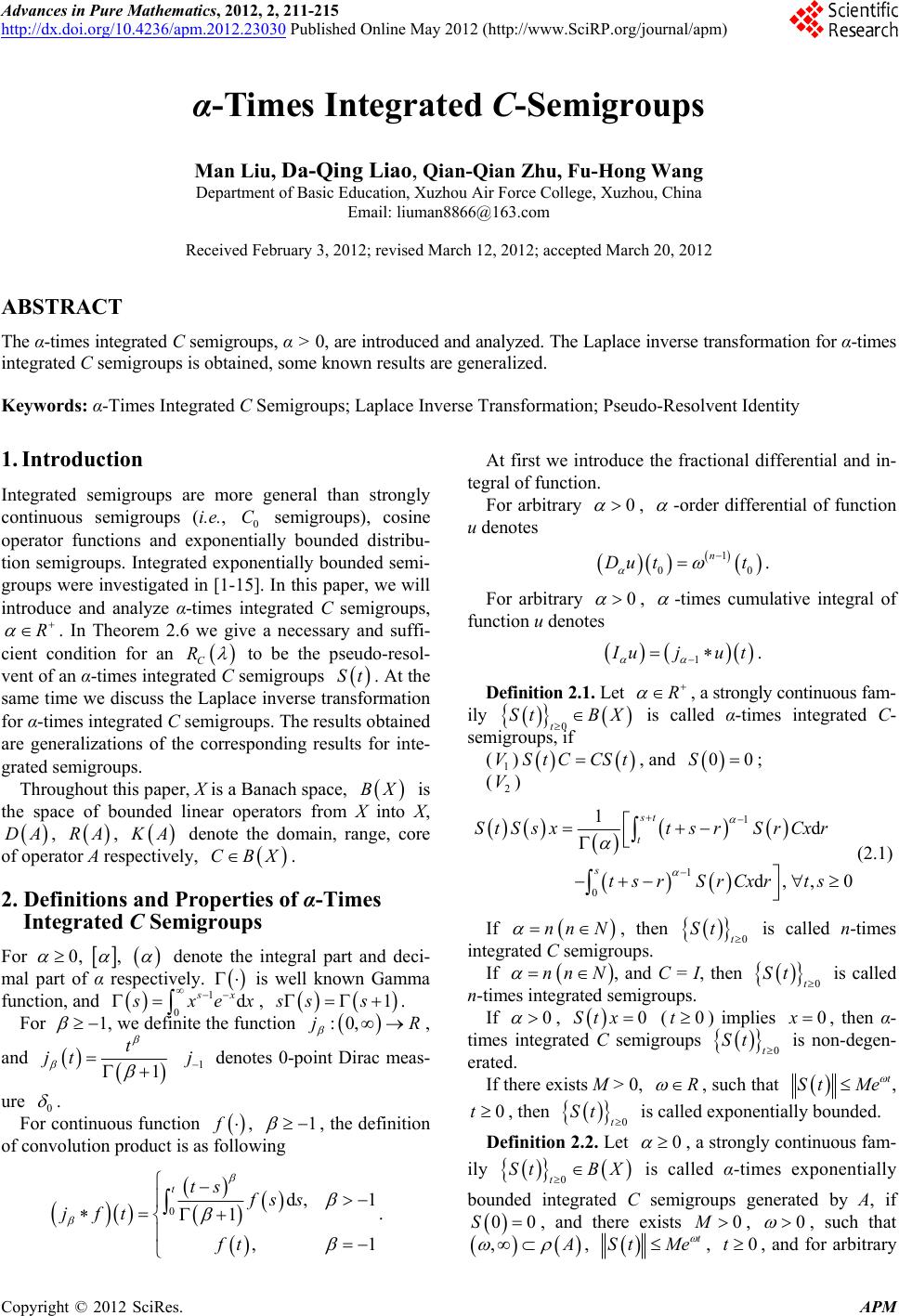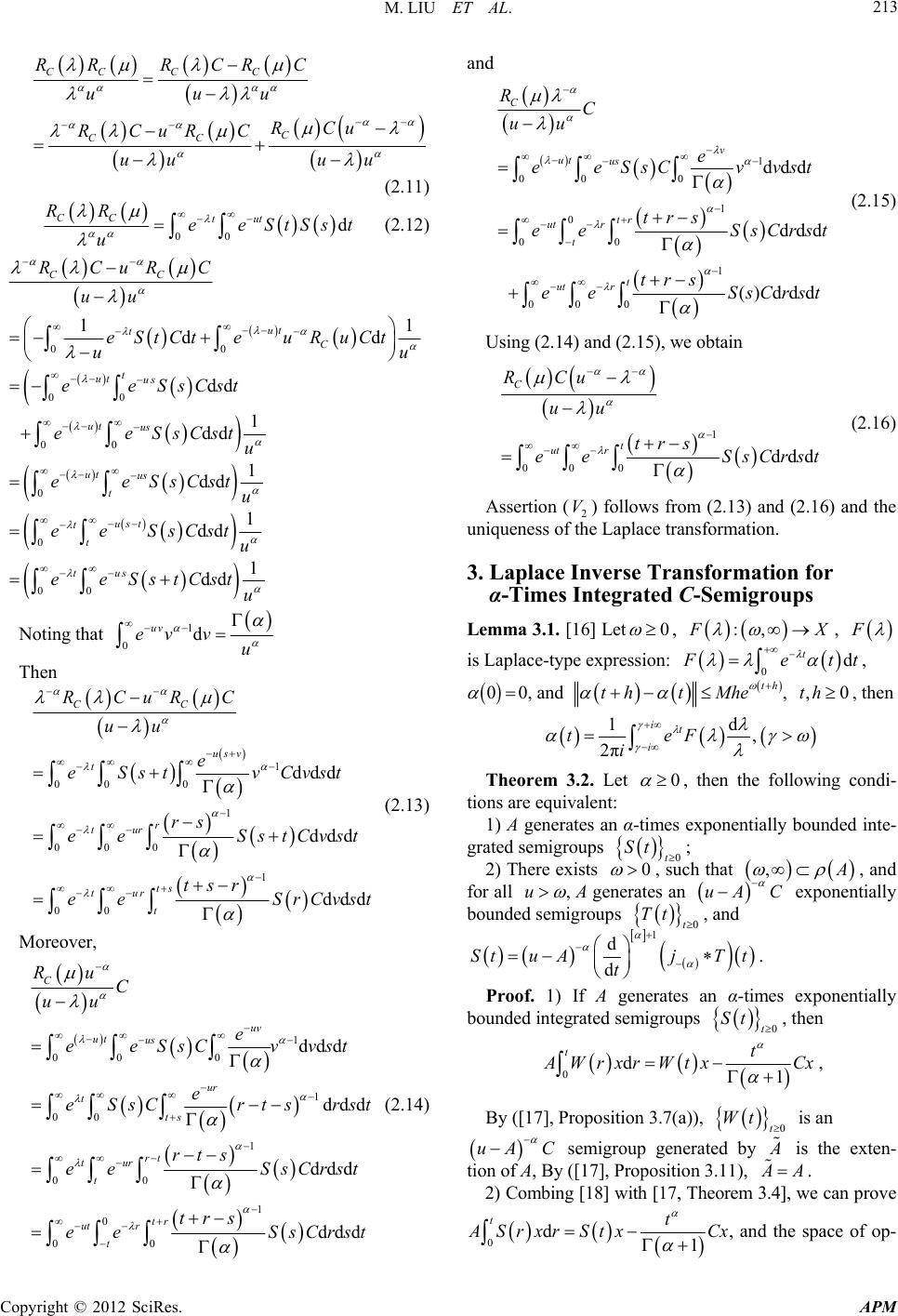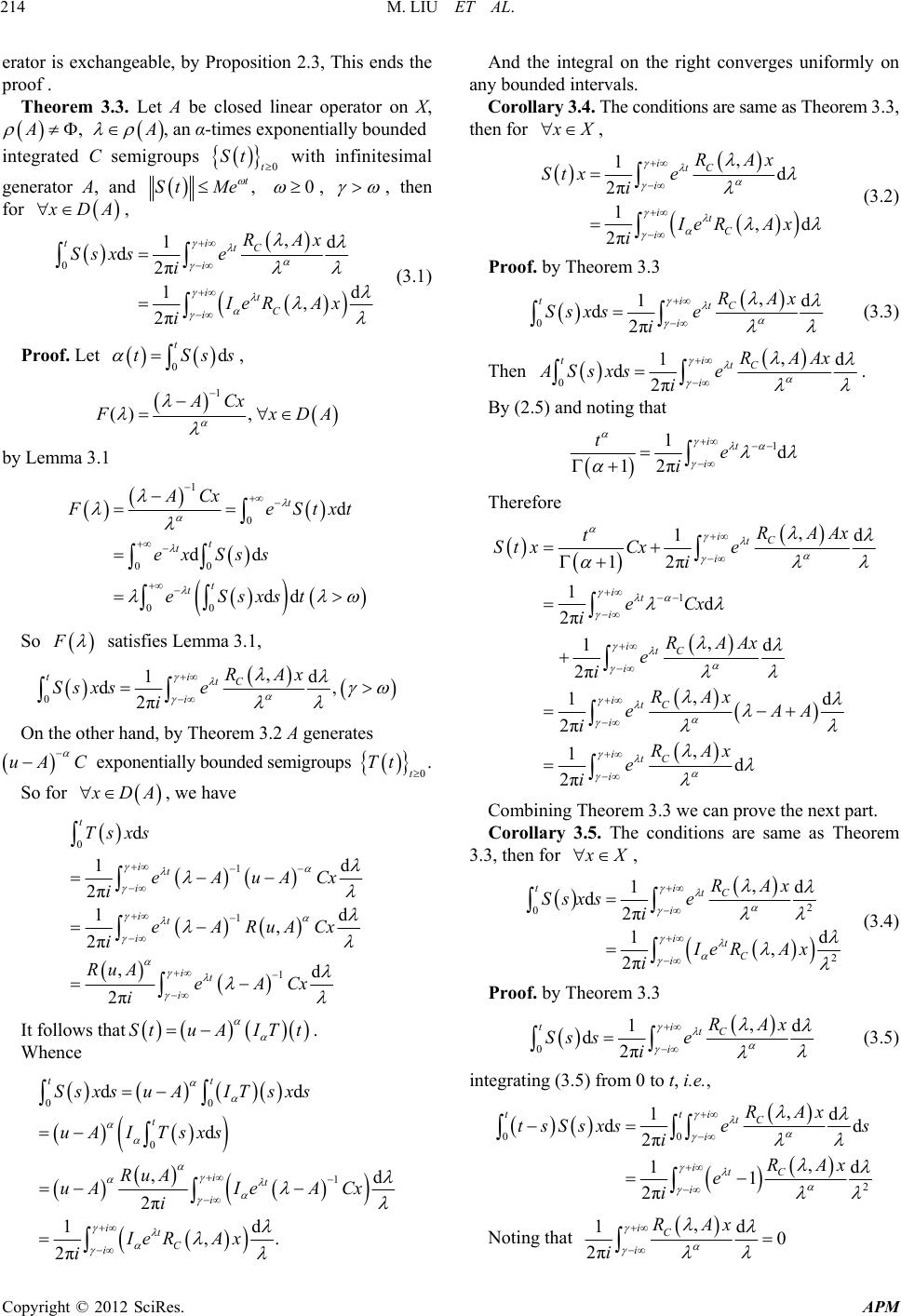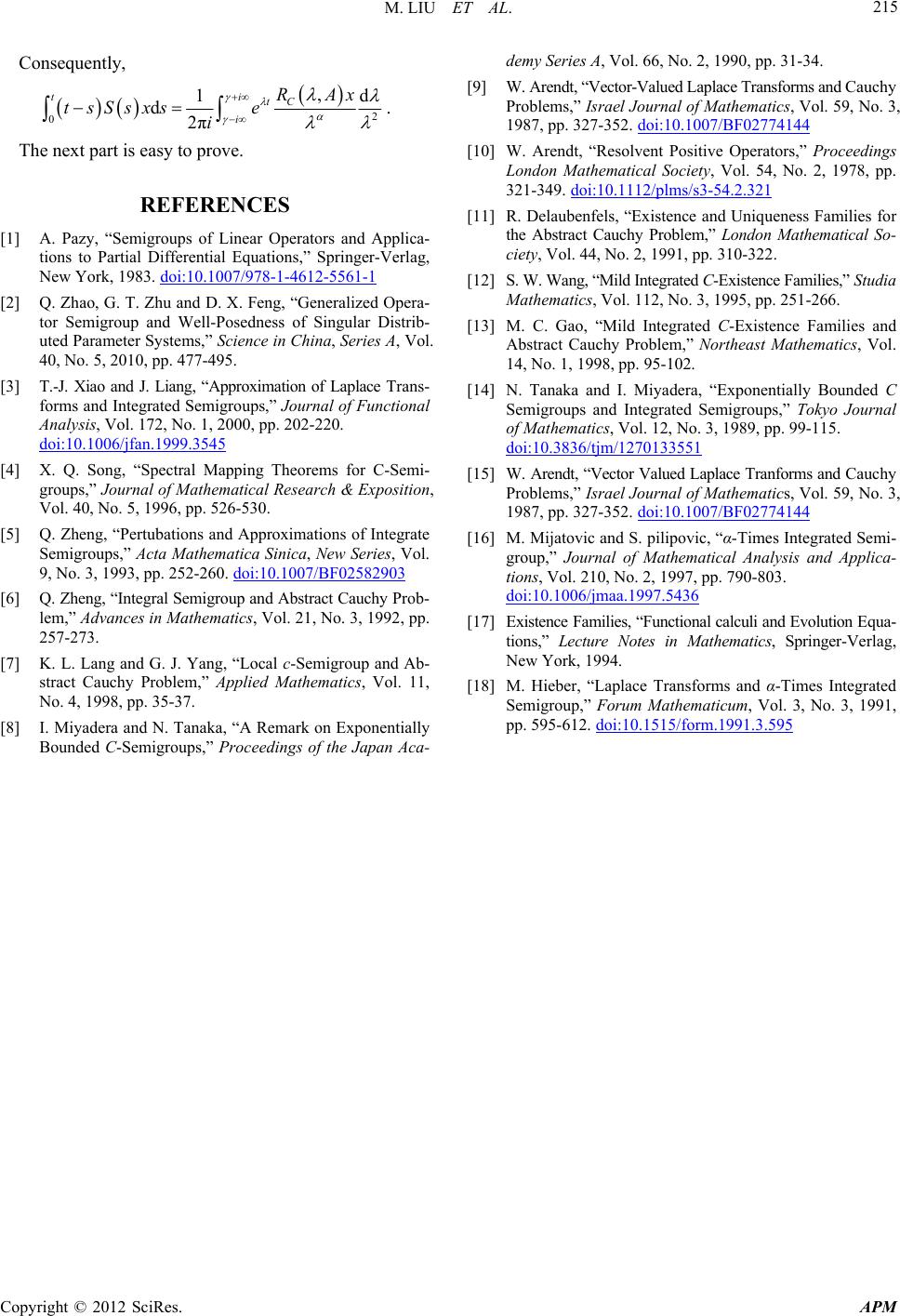 Advances in Pure Mathematics, 2012, 2, 211-215 http://dx.doi.org/10.4236/apm.2012.23030 Published Online May 2012 (http://www.SciRP.org/journal/apm) α-Times Integrated C-Semigroups Man Liu, Da-Qing Liao, Qian-Qian Zhu, Fu-Hong Wang Department of Basic Education, Xuzhou Air Force College, Xuzhou, China Email: liuman8866@163.com Received February 3, 2012; revised March 12, 2012; accepted March 20, 2012 ABSTRACT The α-times integrated C semigroups, α > 0, are introduced and analyzed. The Laplace inverse transformation for α-times integrated C semigroups is obtained, some known results are generalized. Keywords: α-Times Integrated C Semigroups; Laplace Inverse Transformation; Pseudo-Resolvent Identity 1. Introduction Integrated semigroups are more general than strongly continuous semigroups (i.e., 0 semigroups), cosine operator functions and exponentially bounded distribu- tion semigroups. Integrated exponentially bounded semi- groups were investigated in [1-15]. In this paper, we will introduce and analyze α-times integrated C semigroups, . In Theorem 2.6 we give a necessary and suffi- cient condition for an C C R R to be the pseudo-resol- vent of an α-times integrated C semigroups . At the same time we discuss the Laplace inverse transformation for α-times integrated C semigroups. The results obtained are generalizations of the corresponding results for inte- grated semigroups. St Throughout this paper, X is a Banach space, BX RA is the space of bounded linear operators from X into X, , , DA A denote the domain, range, core of operator A respectively, . CBX 2. Definitions and Properties of α-Times Integrated C Semigroups For 0 , , denote the integral part and deci- mal part of α respectively. 1sx is well known Gamma function, and 0d xe x 1s 1 , . ss For :0,jR , we definite the function , and 1 t jt 1 j denotes 0-point Dirac meas- ure 0 . For continuous function , 1 , the definition of convolution product is as following 01 tts fs jft d, 1 ,1 s ft 0 . At first we introduce the fractional differential and in- tegral of function. For arbitrary , -order differential of function u denotes 1 00 n Du tt 0 . For arbitrary , -times cumulative integral of function u denotes 1 ujut R . Definition 2.1. Let , a strongly continuous fam- ily St BX 1 0t is called α-times integrated C- semigroups, if StCCSt, and (V)00S 2 ; (V) 1 1 0 1d d, ,0 st t s StSsxts rSrCxr tsrSrCxr ts (2.1) If nn N 0t St , then is called n-times integrated C semigroups. If nn N 0t St 0 , and C = I, then is called n-times integrated semigroups. 0Stx If , (t) implies , then α- times integrated C semigroups is non-degen- erated. 00x 0t St R If there exists M > 0, , such that t St Me , 0t 0t St 0 is called exponentially bounded. , then Definition 2.2. Let , a strongly continuous fam- ily 0t St BX is called α-times exponentially bounded integrated C semigroups generated by A, if 00S , and there exists , 0M0 , such that , , t St Me 0t, , and for arbitrary C opyright © 2012 SciRes. APM  M. LIU ET AL. 212 X ,d t eStxt 0t0 , we have , 1 0 C RAx ACx . (2.2) Proposition 2.3. Let A be the generator of an α-times integrated C semigroups , St . Then 1) For all DA and t, 0 x StAx ,Stx DA ASt (2.3) 0d tSsAxs dxs DA 1 t Stx Cx (2.4) 2) , for all 0 tSs X0t , and and 0d t 1 t SsxsStx Cx d t eStxt Re (2.5) Proof. Letting , 0 C Rx , , ,d, C ARuAx uAStxt Fix , then uA 0 0 ,d t CC t C eStRuAxt R eR for all Re , and X ,,0At . By the uniqueness theo- rem it follows that ,, CC RuASt StRuAu (2.6) This implies (2.3). Let DRe A , then for all , 1 0 1 00 1 00 11 00 d 1 ,, d( t CC tt t tt t tt t CxeCx t RAxRAAx eStxteS eStxted eStxte 0 0 )d dd ddd. tAxt SsAxs SsAxst Then (2.4) follows from the uniqueness theorem. In order to prove (2.5), let X , and , 0Ret , then by (2.3), (2.4), (2.6) we have 00 0 0 d, ,d , tt C t C t C C C SsxsRASsx RASs RASs RAStx d ,d 1 s Axs xs tCx ,,RAAx (2.7) Noting that C Hence, , and by (2.7), (2.5) follows. C RAxCx dSsxsDA R 0 t Corolla ry 2 .4. Let . Then Stx DA for all X 0t and . Then is right differenti- able in if . In that case 0t St Sx x DA 1 d,0, . d t StxAStxCxtx X t : Proposition 2.5. Let DA X be closed linear operator, when uA , we have , 1) The pseudoresolvent identity ,, ,, CC CC RACRAC RARA (2.8) 2) 1 d,1!, d nn n n CC nRACnRA 1, 2,n 1 1 1 ,, , ,, ,,, CC C CC CCC RACAARAC ACARA (2.9) Proof. 1) CCRA RA RACRARA It follows that ,, ,, CC CC RACRAC RARA 1n 2) We apply the mathematical induction when , by (2.8) 2 d,, dCC RACRA nk , (2.9) is complete. i.e., we suppose 1 d,1!, d kk k k CC kRAC kRA then 1 1 1 1 2 1 ddd ,, d dd d1! , d 11!, kk kk CC kk k k C k k C RACRACC kRA C kRA 1nk i.e., it follows . The proof is complete. Theorem 2.6. Let St be a stongly continuous op- erator function, and t St Me 0t 0d t C ReStxt , , , letting Re . Then Re C R satisfies the pseudoresolvent CC RR CC RCRC (2.10) if and only if St satisfies (2 V). hcondition. Proof. One can easily prove te necessary prove it is sufficiet. Let us thatn Letting Re , Reu , and u . Then the re- solvent equation implies Copyright © 2012 SciRes. APM  M. LIU ET AL. 213 CC CC R CRC uu C CC R R u RCu RCuRC uuuu (2.11) d t StSst 00 CC tu RR ee u (2.12) 00 00 00 0 0 00 dd 1 dd 1 dd 1 dd 1 dd CC ut t C t ut us ut us ut us t us t t t tus RCuRC uu eStCteu u eeSsCst eeSsCst u eeSsCst u eeSsCst u eeSstCst u 11 dd RuCt u Noting that 1dvu 0 uv ev Then 1ddd ddd ddd vCvst stCvst SrCvst (2.13) Moreover, 00 0 1 000 1 00 CC us v t r tur ts tur t RCuRC uu e eSst rs ee S tsr ee 1 1 ddd ddd ddd ddd uv ut us ur t ts rt tu r t tr ut r t C e ee SsC vvst e eSsCrts rst rt s eeS sCrst trs ee SsCrst (2.14) and 00 0 00 1 00 1 0 00 C Ru uu 1 00 0 1 0 00 1 00 0 ddd ddd () ddd C v ut us tr ut r t t ut r RC uu e eeSsC vvst trs e eSsCrst trs ee SsCrst Using (2.14) and (2.15), we obtain (2.15) 1 00 0ddd C t ut r RCu uu trs ee SsCrst (2.16) Assertion (2 V) follows from (2.13) and (2.16 uniqueness of the Laplace transformation. 3. Laplace Inverse Transformation for α-Times Integrated C-Semigroups Lemma 3.1. [16] Let0 ) and the , :,X , F is 0d t Laplace-type expression: ett , 00 , and th tht Mhe , ,0th, then 1d , 2π it i teF i Theorem 3.2. Let 0 , then the following condi- tioalns are equivent: 1) A generates an α-times exponentially bounded inte- grated semigroups St ; 0t 2) There exists 0 , such that , for all u , and , A generates an uA C expone unded semigroups ntially bo Tt , and t0 1 T t . Proo If A generates an α-times exponentially bounded integrated semigroups 0t St , then d St u Aj t d f. 1) 01 d tt Wrxr WtxCx , oup g By ([17], Proposition 3.7(a)), 0t Wt is an uAC semigrenerated by is the exten- tion of A, By ([17], Proposition 3.11), A . mbnheorem 3.4] 2) Coig [18] with [17, T, we can prove 01 t d t Srxr StxCx , an d the space of op- Copyright © 2012 SciRes. APM  M. LIU ET AL. 214 erator is exchangeable, by Proposition 2.3, This ends the proof . Theorem 3.3. Let A be closed linear operator on X, A , , an α-times exponentially bounded integrated C semigroups 0t wititesimal gene St h infin rator A, and , t Me St 0 , , then for DA, 0 , CAx 1d d ti t R Ssxse 2π 1d i it i Ie R , 2πC iAx i (3.1) Proof. Let 0d t tSss, 1 () , ACx xDA by Lemma 3.1 1 d t AC 0 00 00 dd dd t t t t x eS ex Sss eSsxst txt So F satisfies Lemma 3.1, , 1d , 2π ti tC i RAx s e i 0dSsx On the other hand, by Theorem 3.2 A generates uAC exponentially bounroups ded semig 0t Tt . So for DA, we have 0 1 1 1 d 1d 2π 1d , 2π d 2π t it i it i Tsxs eAuACx i eARuACx i RCx ,it i uAeA i AIT t . It follows that St u Whence 00 0 1 ,d 2π 1d ,. 2π t it i it C i Ss AI T RuA uAIeACx i Ie RAx i ddxsuAITsxs dusxs tt And the integral on the right converges uniformly on any bounded intervals. Corollary 3.4. The conditions are same as Theorem 3.3, then for X, , 1d 2π 1,d 2π itC i it C i RAx Stx e i Ie RAx i (3.2) rem 3.3 Proof. by Theo 0 , 1d d2π i tC i RAx Ssxse i t (3.3) Then 0 , 1d d2π ti tC i RAAx ASsxs e i . By (2.5) and noting that 1 1d 12π it i te i Therefore 1 , 1d 1d 2π , 1d 2π , 1d , 1d 2π i it i iC t i iC t i RAAx eCx i RAAx e i RAxAA RAx e i 12π C t i StxCx e i 2π iC t ie i t ining Theorem 3.3 we can prove the next pa ry 3.5. The conditions are same as The 3. Combrt. Corolla o rem 3, then for X , 2 0 2 , 1d d2π 1d , 2π ti tC i it C i RAx Ssxse i Ie RAx i (3.4) Proof. by Theorem 3.3 0 , 1d d2π ti tC i RAx Ss se i (3.5) integrating (3.5) from 0 to t, i.e., 00 2 , 1d dd 2π , 1d 1 2π tti tC i itC i RAx tsSsxses i RAx e i Noting that , 1d 0 2π iC i RAx i Copyright © 2012 SciRes. APM  M. LIU ET AL. Copyright © 2012 SciRes. APM 215 Consequently, 2 d2π tC i Ssx e i 0 , 1d ti RAx ts s . The next part is easy to prove. REFERENCES [1] of Linear Operators and Applica- tial Equations,” Springer-Verlag New York, 1983. doi:10.1007/978-1-4612-55 A. Pazy, “Semigroups tions to Partial Differen , 61-1 lized Opera- [2] Q. Zhao, G. T. Zhu and D. X. Feng, “Genera ness of Singular Distrib- ce in China, Series A, Vol 40, No. 5, 2010, pp. 477-495. [3] T.-J. Xiao and J. Liang, “Approximation of Laplace T forms and Integrated Semigroups,” Journal of Functional Analysis, Vol. 172, No. 1, 2000, pp. 202-220. doi:10.1006/jfan.1999.3545 tor Semigroup and Well-Posed uted Parameter Systems,” Scien . ras-n [4] X. Q. Song, “Spectral Mapping Theorems for C-Semi- urnal of Mathematical Research & Exposition Vol. 40, No. 5, 1996, pp. 526-530. [5] rtubations and Approximations of Integrate Semigroups,” Acta Mathematica Sinica, New Series 9, No. 3, 1993, pp. 252-260. doi:10.1007/BF02582903 groups,” Jo , Q. Zheng, “Pe , Vol. [6] ract Cauchy Prob- , Vol. 21, No. 3, 1992, pp. 257-273. [7] K. L. Lang anemigroup and Ab- stract Cauchyhematics, Vol. 11, n Aca- . 3, demy Series A, Vol. 66, No. 2, 1990, pp. 31-34. [9] W. Arendt, “Vector-Valued Laplace Transforms and Cauchy Problems,” Israel Journal of Mathematics, Vol. 59, No 1987, pp. 327-352. doi:10.1007/BF02774144 [10] W. Arendt, “Resolvent Positive Operators,” Proceedings London Mathematical Society, Vol. 54, No. 2, 1978, pp. 321-349. doi:10.1112/plms/s3-54.2.321 [11] R. Delaubenfels, “Existence and Uniqueness Families for the Abstract Cauchy Problem,” London Mathematical So- . 99-115. ciety, Vol. 44, No. 2, 1991, pp. 310-322. [12] S. W. Wang, “Mild Integrated C-Existence Families,” Studia Mathematics, Vol. 112, No. 3, 1995, pp. 251-266. [13] M. C. Gao, “Mild Integrated C-Existence Families and Abstract Cauchy Problem,” Northeast Mathematics, Vol. 14, No. 1, 1998, pp. 95-102. [14] N. Tanaka and I. Miyadera, “Exponentially Bounded C Semigroups and Integrated Semigroups,” Tokyo Journal of Mathematics, Vol. 12, No. 3, 1989, pp doi:10.3836/tjm/1270133551 [15] W. Arendt, “Vector Valued Laplace Tranforms and Cauchy Problems,” Israel Journal of Mathematics, Vol. 59, No. 3, 1987, pp. 327-352. doi:10.1007/BF02774144 [16] M. Mijatovic and S. pilipovic, “α-Times Integrated Semi- group,” Journal of Mathematical Analysis and Applica- tions, Vol. 210, No. 2, 1997, pp. 790-803. doi:10.1006/jmaa.1997.5436 Q. Zheng, “Integral Semigroup and Abst lem,” Advances in Mathematics [17] Existence Families, “Functional calculi and Evolution Equa- tions,” Lecture Notes in Mathematics, Springer-Verlag, New York, 1994. [18] M. Hieber, “Laplace Transfor d G. J. Yang, “Local c-S Problem,” Applied Mat ms and α-Times Integrated No. 4, 1998, pp. 35-37. [8] I. Miyadera and N. Tanaka, “A Remark on Exponentially Bounded C-Semigroups,” Proceedings of the Japa Semigroup,” Forum Mathematicum, Vol. 3, No. 3, 1991, pp. 595-612. doi:10.1515/form.1991.3.595
|